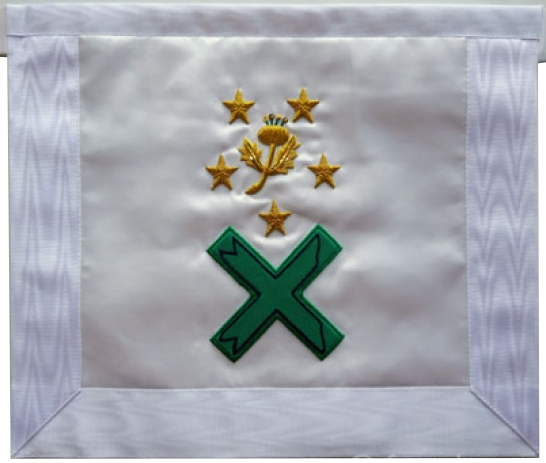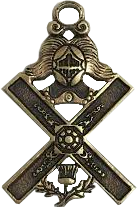ANCIENT & ACCEPTED scottish rite: 29th° DEGREE –
scottish knight of st. Andrew
In Summary:
The 29th degree “Scottish Knight of Saint Andrew” is focused on the qualities of Charity, Clemency, Generosity, Humanity, Patience, and Self-Denial, and teaches Honor and Chivalry.
Initial Note:
The virtues of this degree are “Love of God, loyalty to superiors, faithful adherence to promise, and active resistance to unfair judgment.”
Regalia Notes:
A Knight of St. Andrew wears a green collar edged with crimson, over the neck, and a white silk scarf, fringed with gold and worn from left to right.
The jewel is a St. Andrew’s Cross, of gold, with a large emerald in the center, surmounted by the helmet of a knight, and with a thistle of gold between the arms at the bottom. It is worn suspended from the collar.
The emerald signifies the manliness and uprightness of chivalry, its color that of the renewal of virtue, always bright and sparkling. The thistle is the national emblem of Scotland and recalls a tradition that the Danes invaded Scotland and stealthily surrounded Stained Castle.
They took off their shoes to wade the moat, only to find it dry and filled with thistles. The resultant yells and curses roused the garrison, and the Danes were soundly defeated (Leach, p. 1108). The banner of the Order is a green St. Andrews Cross on a white field fringed with gold.
At the end of each arm of the cross is one of the four Hebrew letters that form the Ineffable Name of Deity. Above the cross is a circle of five stars with a thistle in the center.
Duties are:
• Reverence and obedience to the Deity. Serve the truth.
Protect virtue and innocence. Defend the people against tyranny.
For Reflection:
• Is virtue an armor stronger that the strongest metal?
Lessons:
• Ideas and institutions wax and wane in the great cycle of time which is but change.
Important Symbols:
• St. Andrews Cross, a castle in ruins, armourless knight.
Additional notes:
St. Andrew is said to have been crucified on an X-Shaped cross, although there is no historical evidence to support this claim. Andrew is a Greek name and means “manly”. St. Andrew was the brother of St. Peter and one of the first disciples chosen by Jesus. His character is one to be emulated; the Interpreter’s Dictionary of the Bible describes St. Andrew:
“He was continually open to new light; he was pliable and teachable. When truth broke upon him, he accepted it enthusiastically and wished others to share it” (Vol. A-D, p.126)
St. Andrew is the patron saint of Scotland, and the cross bearing his name appears on the Scottish flag. He is said to have appeared to Hungus, King of the Picts in the ninth century, promising him victory in a battle with the English King Athelstan who sought to conquer Scotland. In the sky that night St. Andrew placed the shape of the cross on which he was crucified as a token of this promise or covenant. The Picts defeated Athelstan and thereby maintained their liberty, for a while.
Sources:
Purchase ‘A Bridge To Light‘ by Rex R. Hutchens
Purchase ‘Morals & Dogma‘ by Albert Pike.
Additional Sources:
https://www.houstonscottishrite.org/fellowship/knights-of-st-andrew/
http://www.galvestonscottishrite.org/index.php/committee/14-knights-of-st-andrew

‘Scottish Knight of Saint Andrew’
Please view the video on the left, for a more detailed explanation of the 29th° Degree.




